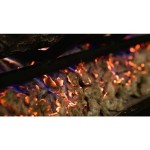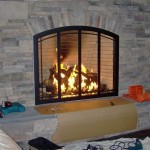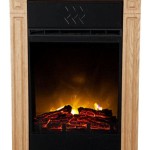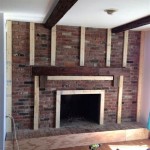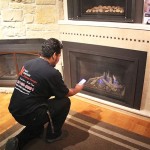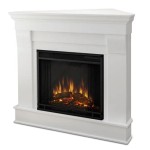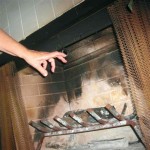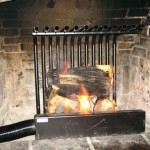What is the Smallest Electric Fireplace?
Electric fireplaces have become increasingly popular as a convenient and aesthetically pleasing alternative to traditional wood-burning or gas fireplaces. Their ease of installation, lack of emissions, and realistic flame effects make them attractive options for homes, apartments, and even offices. One key consideration for potential buyers, particularly those in smaller spaces, is the size of the unit. The "smallest electric fireplace" isn't a rigidly defined category, but rather encompasses various models designed to maximize functionality while minimizing spatial footprint. Understanding the types, dimensions, and considerations associated with the smallest electric fireplaces is crucial for making an informed purchase.
Identifying the absolute smallest electric fireplace can be challenging because "smallest" can refer to different dimensions. It might be the shortest in height, the narrowest in width, or the least deep protruding from the wall. The intended mounting style also influences what is considered "small." A wall-mounted or recessed fireplace might have a larger overall surface area but a minimal projection into the room. Conversely, a freestanding stove-style electric fireplace might have a small footprint but a considerable height. Therefore, it's essential to clarify the specific dimensional limitations you're working within.
Several categories of electric fireplaces cater to those seeking compact designs. These include wall-mounted units, tabletop models, and small freestanding stoves. Each type offers unique advantages and disadvantages in terms of installation, heating capacity, and visual appeal. Understanding these distinctions will guide the selection process towards the most suitable option for a given space.
Types of Small Electric Fireplaces
The market offers diverse options for small electric fireplaces, each designed to suit different needs and aesthetic preferences. The primary categories are: wall-mounted, tabletop, and freestanding stove-style models. Each has different spatial implications and benefits in terms of heating output and design.
Wall-Mounted Electric Fireplaces: These are designed to be hung on a wall, similar to a picture frame or television. This is the most common category when people are trying to save space. They come in various sizes, with some models being remarkably slim. The smallest wall-mounted units can be as narrow as 18-24 inches in width and only a few inches deep. Wall-mounted fireplaces are excellent for adding a focal point to a room without taking up valuable floor space. Installation typically involves mounting a bracket to the wall and then hanging the fireplace unit. Some higher-end models may require professional installation, particularly if hardwiring to a dedicated electrical circuit is desired.
Wall-mounted models often feature multiple flame color options and adjustable brightness settings. They may also include a built-in timer and thermostat for automated operation. The heating capacity of wall-mounted electric fireplaces varies, but even smaller units can effectively heat a room of 100-400 square feet. The visual appeal of wall-mounted models ranges from minimalist designs to more elaborate styles with realistic log sets and ember beds.
Tabletop Electric Fireplaces: These are designed to sit on a tabletop, mantel, or other flat surface. They are typically smaller than wall-mounted or freestanding units and are ideal for adding ambiance and supplemental heat to a small area. Tabletop fireplaces are often compact, with dimensions ranging from 12-18 inches in width and height. They usually plug into a standard electrical outlet and are very easy to install.
Tabletop models are often chosen for their portability and ease of use. They are suitable for apartments, offices, or any room where a larger fireplace is not feasible. While their heating capacity is generally lower than that of wall-mounted units, they can still provide a noticeable warming effect in a small area. Design options for tabletop fireplaces range from traditional styles with faux logs to more contemporary designs with colored glass or pebbles.
Freestanding Stove-Style Electric Fireplaces: These are designed to mimic the appearance of a traditional wood-burning stove. While they may not be the absolute smallest in terms of overall volume, they often have a small footprint, making them suitable for corners or other tight spaces. The smallest freestanding stove-style electric fireplaces can be as narrow as 15-20 inches wide and deep. They typically feature a metal or wood-like cabinet and a realistic-looking flame effect.
Freestanding stove-style fireplaces are popular for their rustic charm and ability to add a cozy atmosphere to a room. They are typically easy to install, requiring only a standard electrical outlet. The heating capacity of freestanding stove-style models is generally comparable to that of wall-mounted units, making them suitable for heating rooms of 200-400 square feet. Some models also include features such as adjustable flame speed, temperature control, and remote control operation.
Key Considerations When Choosing a Small Electric Fireplace
Selecting the right small electric fireplace involves weighing several factors to ensure it meets your specific needs and preferences. These considerations include heating capacity, dimensions, installation requirements, aesthetic appeal, and safety features. Additionally, the cost of the unit and its operational expenses should be taken into account.
Heating Capacity: The primary function of an electric fireplace is to provide supplemental heat. Therefore, it's crucial to choose a model with sufficient heating capacity for the intended space. Electric fireplaces are typically rated in terms of British Thermal Units (BTUs) or wattage. A general rule of thumb is that 1,500 watts (approximately 5,100 BTUs) can heat a room of around 400 square feet. However, this can vary depending on factors such as insulation, ceiling height, and the number of windows in the room. If the fireplace is intended for supplemental heating only, a smaller unit with a lower BTU rating may suffice. For larger spaces or those that require more consistent heating, a more powerful model is recommended.
Dimensions and Space Constraints: When selecting a small electric fireplace, careful consideration must be given to the available space. Measure the area accurately to ensure that the chosen unit will fit comfortably without obstructing walkways or other furniture. Pay attention to the depth of the fireplace, particularly for wall-mounted models, to ensure that it does not protrude excessively into the room. For freestanding stove-style fireplaces, consider the footprint and the amount of floor space required. In some cases, a corner fireplace may be the best option for maximizing space utilization.
Installation Requirements: Electric fireplaces are generally easy to install compared to traditional fireplaces. However, the installation requirements can vary depending on the type of unit and its features. Wall-mounted fireplaces typically require mounting a bracket to the wall, which may involve drilling and securing the bracket with screws. Consider the type of wall (drywall, plaster, or concrete) and ensure that the mounting hardware is appropriate. Some wall-mounted models may require hardwiring to a dedicated electrical circuit, which should be performed by a qualified electrician. Tabletop and freestanding stove-style fireplaces are typically plug-and-play, requiring only a standard electrical outlet. However, it's essential to ensure that the outlet is properly grounded and can handle the electrical load of the fireplace.
Assessing Features and Safety of Small Electric Fireplaces
Beyond the basic functionality of providing heat and visual appeal, modern electric fireplaces offer a range of features that enhance their usability and safety. These include adjustable flame settings, temperature control, timers, remote control operation, and safety features such as overheat protection. Evaluating these features is essential for selecting a model that meets your specific needs and provides peace of mind.
Adjustable Flame Settings: One of the key benefits of electric fireplaces is their ability to simulate the look of a real fire without the associated hazards and maintenance. Most models offer adjustable flame settings, allowing you to customize the appearance of the flames to your liking. These settings may include adjusting the flame color, brightness, and speed. Some higher-end models also feature realistic flame effects that mimic the flickering and dancing of a real fire.
Temperature Control and Timers: Electric fireplaces typically include a thermostat that allows you to set the desired room temperature. The fireplace will then automatically turn on and off to maintain the set temperature. This feature helps to conserve energy and prevent overheating. Many models also include a timer function, which allows you to set the fireplace to turn off automatically after a specified period. This is useful for warming a room before bedtime or for ensuring that the fireplace does not run continuously when you are not present.
Remote Control Operation: Many electric fireplaces come with a remote control that allows you to adjust the settings from a distance. This is particularly convenient for wall-mounted models that may be mounted high on the wall. The remote control typically allows you to adjust the flame settings, temperature, timer, and power on/off. Some models also offer smart home integration, allowing you to control the fireplace using a smartphone or voice assistant.
Safety Features: Safety is a paramount consideration when choosing an electric fireplace. Look for models that include safety features such as overheat protection. This feature automatically shuts off the fireplace if it detects that it is overheating, preventing potential fires or damage to the unit. Some models also include a cool-touch exterior, which prevents the surface of the fireplace from becoming too hot to touch. It is important to follow all safety instructions provided by the manufacturer and to ensure that the fireplace is properly installed and maintained.
In conclusion, the "smallest electric fireplace" encompasses a variety of models tailored for space-conscious environments. Understanding the different types, assessing key features, and prioritizing safety are vital steps in choosing the right electric fireplace for your specific needs and spatial limitations. By carefully considering these factors, you can select a compact and efficient electric fireplace that adds warmth, ambiance, and style to your home without compromising valuable space.

ᑕ❶ᑐ 10 Stunning Electric Fireplaces Perfect For Small Spaces

Comfort Glow The Mini Hearth Electric Fireplace Black Office Depot

50 In Wall Mounted Ultra Thin Tempered Glass Front Smart Electric Fireplace With Remote And Multi Color Flame Black

Dimplex Winslow 42 Wall Mounted Tabletop Linear Electric Fireplace

Dimplex Optimyst Revive 25 Water Vapor Fireplace Abn15

Small Electric Fireplace Inserts Fireplaces Direct

Edendirect 36 In Ventless Electric Fireplace Insert Remote Control Adjustable Led Flame Brightness 750 Watt 1500 Nblw Ry 936a

Duraflame Electric Fireplace Review We Tested It 2025

ᑕ❶ᑐ Do Electric Fireplaces Come In A Smaller Size Blog

Dimplex Revillusion 42 Herringbone Brick Built In Electric Firebox With Glass Pane And Plug Kit

